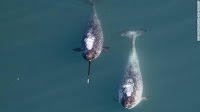Scientists are learning something about climate change from the narwhal's tusk. The Arctic, where the narwhal makes its home, is warming twice as fast as the rest of the planet. We know this from numerous scientific surveys and researches including studies of ice core samples dating back hundreds of thousands of years taken from the Greenland ice cap. Researchers writing in the journal Current Biology, have found narwhal tusks contain an increasing amount of mercury over the period 1962 to 2010. Reading the tusks growth patterns like tree rings, mercury increased an average of 0.3% per year, but between 2000 and 2010, a period of marked warming in the Arctic region, mercury content increased 1.9% per year.
Mercury is a potent neurotoxin that bio-accumulates over time--tt stays in the food chain and top predators accumulate the toxin like polar bears. Bears are able to sequester it in their thick fur, but narwhals cannot do so. A narwhal can live for fifty years, so the toxic can reach very high levels that might have cognitive or reproductive effects.
Tusks also reveal that diets have changed over time. Prior to 1990 whales fed on ice-cold water fish--Arctic cod and halibut. There is a shift to open ocean species like capelin indicating a loss of sea ice. Arctic species are more nutritious for narwhals who need to pack on fat to survive their habitat. Dietary changes to lower energy food coupled with increasing mercury levels presents a threat to any predator.
Another troubling signal of changing ocean environments has emerged from the waters off the west coast of northern California. Satellite imagery shows the dense kelp (Nereocystis luetkeana) forests that dominated the near shore for hundreds of miles have been wiped out by a series of environmental impacts since 2013. The kelp forests were home to numerous species including abalone. A new study by UC Santa Cruz shows that the kelp canopy along the Sonoma and Mendicino coasts has declined by 95%. Two factors have been identified in the decline of this productive ecosystem: the purple sea urchin and two marine heat waves referred to as a warm water "blob". The purple urchin which feeds on kelp has exploded in numbers due to the demise of the sunflower sea star because of a wasting disease. What is left as a result of the imbalance are "urchin barrens"--rocky areas completely covered with the spiky purple invertebrates over hundreds of kilometers of the North Coast--where once thrived an entire marine community created by the kelp. Scientist are not sure kelp will rebound any time soon, Manually removing the purple kelp eater is not easy; unless the sunflower sea star or another predator returns, the purple sea urchin shows no sign of budging.
The loss of valuable marine habitat has had economic effects, too. The state was forced to close recreational diving for abalone for five years in 2018. The last dive shop in the area closed about a year ago. Purple urchins are not as commercially valuable as red urchins, but that could change if a market is developed for them. Some efforts are going forward to create kelp farms and spore banks for replantation when and if conditions improve.

